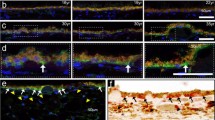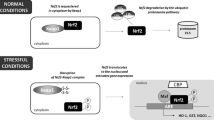Abstract
Purpose
Clock genes are components of the molecular clock. Their malfunction is thought to increase the risk of numerous diseases, including cancer. Vascular endothelial growth factor (VEGF) has a pivotal role in angiogenesis, and its expression levels are controlled by clock genes in tumor cells. Ophthalmic diseases such as age-related macular degeneration, proliferative diabetic retinopathy, and neovascular glaucoma are also associated with abnormal angiogenesis followed by upregulation of VEGF in the eye. In the present study, we aimed to uncover the relationship between clock genes and VEGF in the eye.
Study design
Laboratory investigation
Methods
Oxygen-induced retinopathy (OIR) mice were prepared to mimic hypoxic conditions in the eye. Deferoxamine (DFO) was used to mimic hypoxic conditions in human Müller cell line MIO-M1 cells. Expression levels of mRNA and protein were quantified by quantitative reverse transcription polymerase chain reaction and Western blot analysis, respectively.
Results
In the retinas of OIR mice, the expression levels of Vegf and the clock gene Dec2 increased transiently, and their temporal profiles were correlated. Knockdown of DEC2 resulted in a significant (26.7%) reduction of VEGF expression in MIO-M1 cells under hypoxia-mimicking conditions induced by DFO (P < .05). Levels of HIF1α protein were also reduced significantly, by 60.2%, in MIO-M1 cells treated with siRNA against the DEC2 gene (P < .05). Moreover, HIF1α levels showed a significant (2.5-fold) increase in MIO-M1 cells overexpressing DEC2 (P < .05).
Conclusion
DEC2 could upregulate retinal VEGF gene expression through modulation of HIF1α levels under hypoxic conditions.




Similar content being viewed by others
References
Willett CG, Boucher Y, di Tomaso E, Duda DG, Munn LL, Tong RT, et al. Direct evidence that the VEGF-specific antibody bevacizumab has antivascular effects in human rectal cancer. Nat Med. 2004;10:145–7.
Gariano RF, Gardner TW. Retinal angiogenesis in development and disease. Nature. 2004;438:960–6.
Osaadon P, Fagan X, Lifshitz T, Levy J. A review of anti-VEGF agents for proliferative diabetic retinopathy. Eye. 2014;28:510–20.
SooHoo JR, Seibold LK, Kahook MY. Recent advances in the management of neovascular glaucoma. Ophthalmol. 2013;28:165–72.
Kimoto K, Kubota T. Anti-VEGF agents for ocular angiogenesis and vascular permeability. J Ophthalmol. 2012;2012:852183.
Selvaraj K, Gowthamarajan K, Karri VVSR, Barauah UK, Ravisankar V, Jojo GM. Current treatment strategies and nanocarrier based approaches for the treatment and management of diabetic retinopathy. J Drug Target. 2017;25:386–405.
Hamet P, Tremblay J. Genetics of the sleep-wake cycle and its disorders. Metab Clin Exp. 2006;55:S7–12.
Ohdo S. Chronopharmacology focused on biological clock. Drug Metab Pharmacokinet. 2007;22:3–14.
Koyanagi S, Kusunose N, Taniguchi M, Akamine T, Kanado Y, Ozono Y, et al. Glucocorticoid regulation of ATP release from spinal astrocytes underlies diurnal exacerbation of neuropathic mechanical allodynia. Nat Commun. 2016;7:13102.
Okamura H, Yamaguchi S, Yagita K. Molecular machinery of the circadian clock in mammals. Cell Tissue Res. 2002;309:47–56.
Ueda HR, Iino M, Machida M, Sano M, Hayashi S, Hashimoto S, et al. System-level identification of transcriptional circuits underlying mammalian circadian clocks. Nat Genet. 2005;37:187.
Hastings MH, Reddy AB, Maywood ES. A clockwork web: circadian timing in brain and periphery, in health and disease. Nat Rev. 2003;4:649–61.
Honma S, Kawamoto T, Takagi Y, Fujimoto K, Sato F, Noshiro M, et al. Dec1 and Dec2 are regulators of the mammalian molecular clock. Nature. 2002;419:841–4.
He Y, Jones CR, Fujiki N, Xu Y, Guo B, Holder JL, et al. The transcriptional repressor DEC2 regulates sleep length in mammals. Science. 2009;325:866–70.
Sato F, Bhawal UK, Yoshimura T, Muragaki Y. DEC1 and DEC2 crosstalk between circadian rhythm and tumor progression. J Cancer. 2016;7:153–9.
Sato F, Bhawal UK, Kawamoto T, Fujimoto K, Imaizumi T, Imanaka T, et al. Basic-helix-loop-helix (bHLH) transcription factor DEC2 negatively regulates vascular endothelial growth factor expression. Genes Cells. 2008;13:131–44.
Koyanagi S, Kuramoto Y, Nakagawa H, Aramaki H, Ohdo S, Soeda S, et al. A molecular mechanism regulating circadian expression of vascular endothelial growth factor in tumor cells. Cancer Res. 2003;63:7277–83.
Nakama T, Yoshida S, Ishikawa K, Kobayashi Y, Abe T, Kiyonari H, et al. Different roles played by periostin splice variants in retinal neovascularization. Exp Eye Res. 2016;153:133–40.
Ren H, Thiersch M, Grimm C. Mimicking hypoxia by the chemical stabilization of Hif-1α in the mouse retina. Invest Ophthalmol Vis Sci. 2007;48:625.
Semenza GL. Hypoxia-inducible factor 1: control of oxygen homeostasis in health and disease. Pediatr Res. 2001;49:614–7.
Nürnberg C, Kociok N, Brockmann C, Lischke T, Crespo-Garcia S, Reichhart N, et al. Myeloid cells contribute indirectly to VEGF expression upon hypoxia via activation of Müller cells. Exp Eye Res. 2018;166:56–69.
Zhang SX, Wang JJ, Gao G, Parke K, Ma JX. Pigment epithelium-derived factor downregulates vascular endothelial growth factor (VEGF) expression and inhibits VEGF-VEGF receptor 2 binding in diabetic retinopathy. J Mol Endocrinol. 2006;37:1–12.
Chen S, Sang N. Histone deacetylase inhibitors: the epigenetic therapeutics that repress hypoxia-inducible factors. J Biomed Biotechnol. 2011;2011:197946.
Joshi S, Singh AR, Durden DL. MDM2 regulates hypoxic hypoxia-inducible factor 1alpha stability in an E3 ligase, proteasome, and PTEN-phosphatidylinositol 3-kinase-AKT-dependent manner. J Biol Chem. 2014;289:22785–97.
Kim EJ, Yoo YG, Yang WK, Lim YS, Na TY, Lee IK, et al. Transcriptional activation of HIF-1 by RORalpha and its role in hypoxia signaling. Arterioscler Thromb Vasc Biol. 2008;28:1796–802.
Akashi M, Okamoto A, Tsuchiya Y, Todo T, Nishida E, Node K. A positive role for PERIOD in mammalian circadian gene expression. Cell Rep. 2014;7:1056–64.
Eckle T, Hartmann K, Bonney S, Reithel S, Mittelbronn M, Walker LA, et al. Adora2b-elicited Per2 stabilization promotes a HIF-dependent metabolic switch crucial for myocardial adaptation to ischemia. Nat Med. 2012;18:774–82.
Kobayashi M, Morinibu A, Koyasu S, Goto Y, Hiraoka M, Harada H. A circadian clock gene, PER2, activates HIF-1 as an effector molecule for recruitment of HIF-1α to promoter regions of its downstream genes. FEBS J. 2017;284:3804–16.
Montagner M, Enzo E, Forcato M, Zanconato F, Parenti A, Rampazzo E, et al. SHARP1 suppresses breast cancer metastasis by promoting degradation of hypoxia-inducible factors. Nature. 2012;487:380–4.
Hu T, He N, Yang Y, Yin C, Sang N, Yang Q. DEC2 expression is positively correlated with HIF-1 activation and the invasiveness of human osteosarcomas. J Exp Clin Cancer Res. 2015;34:22.
Wu Y, Sato H, Suzuki T, Yoshizawa T, Morohashi S, Seino H, et al. Involvement of c-myc in the proliferation of MCF-7 human breast cancer cells induced by bHLH transcription factor DEC2. Int J Mol Med. 2015;35:815–20.
Stahl A, Connor KM, Sapieha P, Chen J, Dennison RJ, Krah NM, et al. The mouse retina as an angiogenesis model. Invest Ophthalmol Vis Sci. 2010;51:2813–26.
Olkkonen J, Kouri V, Hynninen J, Konttinen YT, Mandelin J. Differentially expressed in chondrocytes 2 (DEC2) increases the expression of IL-1β and is abundantly present in synovial membrane in rheumatoid arthritis. PloS One. 2015;10:e0145279.
Kaštelan S, Tomić M, Gverović Antunica A, Salopek Rabatić J, Ljubić S. Inflammation and pharmacological treatment in diabetic retinopathy. Mediators Inflamm. 2013;2013:213130.
Juel HB, Faber C, Udsen MS, Folkersen L, Nissen MH. Chemokine expression in retinal pigment epithelial ARPE-19 cells in response to coculture with activated T Cells. Invest Ophthalmol Vis Sci. 2012;53:8472–80.
Mahoney MM. Shift work, jet lag, and female reproduction. Int J Endocrinol. 2010;2010:813764.
Haus E, Smolensky M. Biological clocks and shift work: circadian dysregulation and potential long-term effects. Cancer Causes Control. 2006;17:489–500.
Myers BL, Badia P. Changes in circadian rhythms and sleep quality with aging: mechanisms and interventions. Neurosci Biobehav Rev. 1995;19:553–71.
Kusunose N, Matsunaga N, Kimoto K, Akamine T, Hamamura K, Koyanagi S, et al. Mitomycin C modulates the circadian oscillation of clock gene period 2 expression through attenuating the glucocorticoid signaling in mouse fibroblasts. Biochem Biophys Res Commun. 2015;467:157–63.
Lim F, Currie R, Orphanides G, Moggs J. Emerging evidence for the interrelationship of xenobiotic exposure and circadian rhythms: a review. Xenobiotica. 2006;36:1140–51.
Toh KL, Jones CR, He Y, Eide EJ, Hinz WA, Virshup DM, et al. An hPer2 phosphorylation site mutation in familial advanced sleep phase syndrome. Science. 2001;291:1040–3.
Takeda N, Maemura K. The role of clock genes and circadian rhythm in the development of cardiovascular diseases. Cell Mol Life Sci. 2015;72:3225–34.
Takahashi JS, Hong H, Ko CH, McDearmon EL. The genetics of mammalian circadian order and disorder: implications for physiology and disease. Nat Rev Genet. 2008;9:764–75.
Wang Q, Tikhonenko M, Bozack SN, Lydic TA, Yan L, Panchy NL, et al. Changes in the daily rhythm of lipid metabolism in the diabetic retina. PLoS One. 2014;9:e95028.
Wang Q, Bozack SN, Yan Y, Boulton ME, Grant MB, Busik JV. Regulation of retinal inflammation by rhythmic expression of MiR-146a in diabetic retina. Invest Ophthalmol Vis Sci. 2014;55:3986–94.
Acknowledgements
This work was supported by a Grant-in-Aid for Young Scientists (B) (no. 26861456) from the Japan Society for the Promotion of Science.
Author information
Authors and Affiliations
Corresponding author
Ethics declarations
Conflicts of interest
N. Kusunose, None; T. Akamine, None; Y. Kobayashi, None; S. Yoshida, None; K. Kimoto, None; S. Yasukochi, None; N. Matsunaga, None; S. Koyanagi, None; S. Ohdo, None; T. Kubota, None.
Additional information
Corresponding author: Naoki Kusunose
Electronic supplementary material
Below is the link to the electronic supplementary material.


About this article
Cite this article
Kusunose, N., Akamine, T., Kobayashi, Y. et al. Contribution of the clock gene DEC2 to VEGF mRNA upregulation by modulation of HIF1α protein levels in hypoxic MIO-M1 cells, a human cell line of retinal glial (Müller) cells. Jpn J Ophthalmol 62, 677–685 (2018). https://doi.org/10.1007/s10384-018-0622-5
Received:
Accepted:
Published:
Issue Date:
DOI: https://doi.org/10.1007/s10384-018-0622-5




